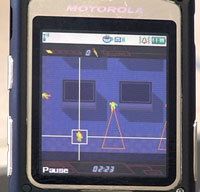Cellphone games: Small size, big money
Hollywood (CA) - Data services have been identified as the single most important revenue opportunity for cellphones in the near future. And it's not just MMS - count on a flood of cellphone games coming your way. TG Daily talked to the developers of "24" - a game related to the popular TV show - about technology challenges and business opportunities.
America has long resisted a global trend to use cellphones for more than just calling. Slowly but surely we are finally catching up with the rest of the world - SMS and MMS already have been gaining traction over the past two years or so and video games is the next trend to penetrate our phones.
Among major mobile content creators is I-play, which has or has taken part in the development of more than 100 mobile phone games in the past seven years. In a recent event in Hollywood, the company launched "24," a game that will be marketed alongside the related television show. It is just another example how traditional media are being tied to new types of entertainment content in order to create additional revenue opportunities - which is not as simple as it may appear on the surface, we learned.
Jonathan Kromrey, technical producer at I-play, told us that the core development of the 24 game took just 90 business days. But in contrast to the PC and console industry, where games have to be fitted to only one or two platforms, a cellphone game has to be converted into 1000 unique builds to fit on phones from 100 different carriers around the world. Conversion takes usually twice the time of original development: According to I-play CEO David Gosen, it "typically takes 7 to 9 months to make a mobile game. One-third of the time is development with two-thirds is needed for conversion."

Given the limited memory size of many phones, developers usually have to squeeze their games into around 150 kB. In fact, for the 24 game, Kromrey told us that I-play had to make three versions to fit high, medium and low memory capacity phones. "The available memory for a game is extremely small, take for instance the 24 game. We had to make a 157 kB, 100 kB and a 64 kB version," he said.
In order to cut the game size, I-play uses old-fashioned programming tricks like limiting the amount of sound and using only a single font. However, the most efficient technique is to simply cut the amount of playable content, he said: "On the lowest end, the 24 game has 4 different games, while the mid and high-end have 6 and 9 games."
Mobile phone games also have to deal with small screen sizes, most often with a tiny space of 176 x 220 pixels. Kromrey said that the austere environment is remiscent of programming in the 1980s, when a maximum of 640 kB was available. "It's like the days of the Commodore 64 or the 386, or before they had SVGA cards," he said. But programming in such a limited environment doesn't frustrate Kromney: "It forces us to focus on the core development."
Stay on the Cutting Edge
Join the experts who read Tom's Hardware for the inside track on enthusiast PC tech news — and have for over 25 years. We'll send breaking news and in-depth reviews of CPUs, GPUs, AI, maker hardware and more straight to your inbox.
The technical differences between mobile phone and console games are evident, but the business side of the two segments is equally dissimilar. Total revenue is much higher with consoles at around $10 billion annually. The mobile phone game market is smaller - according to Gosen around $1.5 billion globally - with half of revenues being generated in Asia and the rest evenly split between Europe and the United States.
Gosen said that a typical mobile phone game costs $200,000 to $500,000 to make and takes seven to nine months to make. He adds that games for the Xbox 360 or the upcoming Playstation 3 cost around $10 to $25 million to make.
Console games are usually bought at a retail store like a Best Buy or Electronic Boutique. Typically housed in a flashy package that comes with a CD/DVD, manual and other items, these games can cost upwards of $50. Mobile phone games, in contrast, are delivered digitally through your carrier, resulting in huge savings. "We operate in a digital world where there is no stock, there is no packaging no shelf life or shelf life date," said Gosen. He added that mobile phone games are usually sold for around $5.
How popular will mobile phone games be in the future? Gosen predicts that phone games will exceed consoles and handheld games in the number of units sold. However since the phone games are generally sold in the five dollar range, he thinks it will be a very long time until the market catches up in terms of total revenue.
Most Popular

